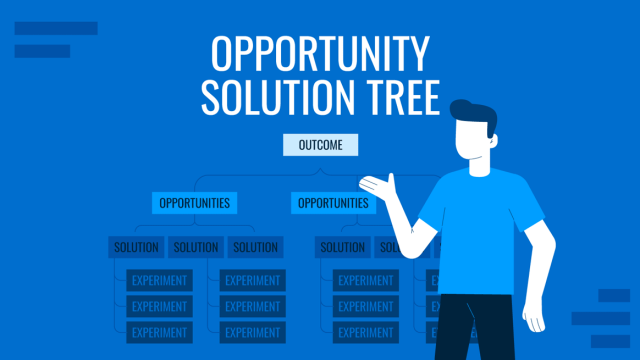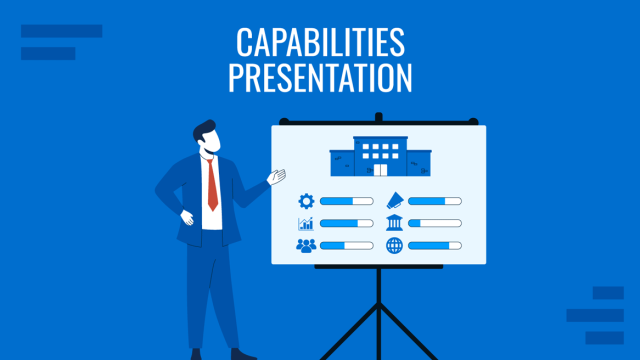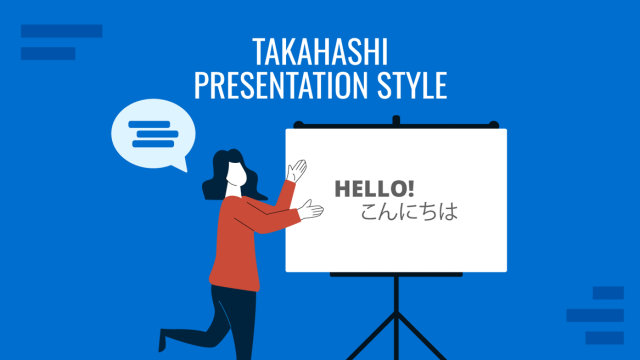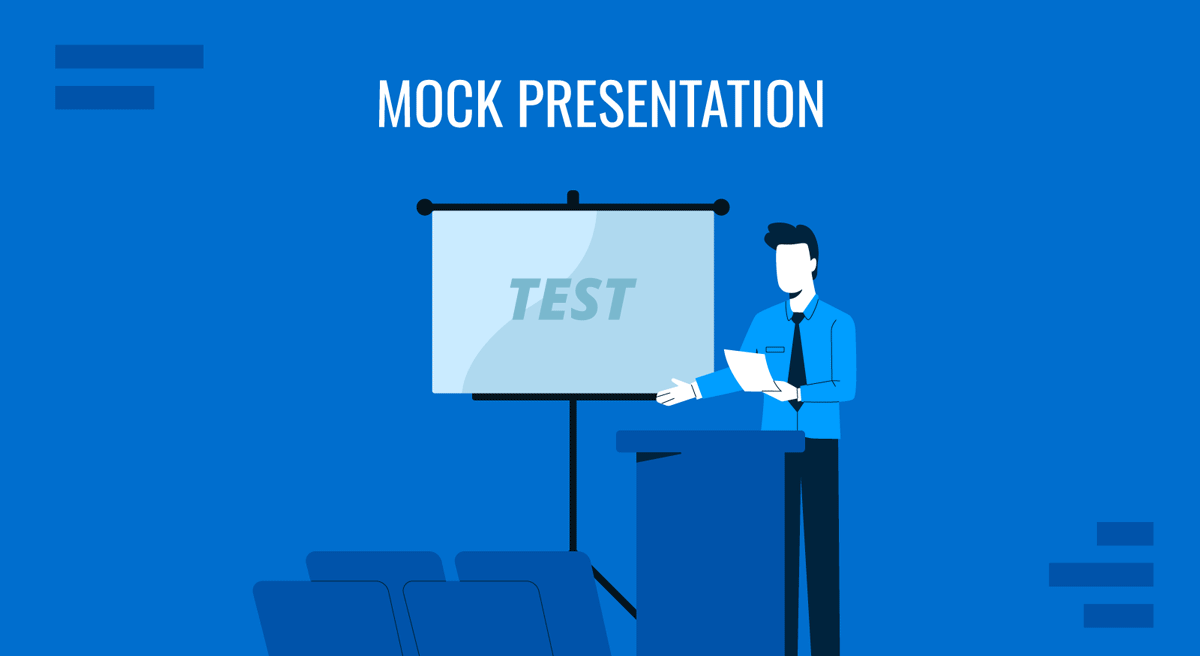
Practice is key to achieving a high-level performance in presentation delivery, especially for marketing, sales, consulting, and corporate professionals. Whether you’re preparing a mock sales pitch interview, a presentation rehearsal, or a mock pitching presentation, the process should follow a structured workflow that allows you to replicate the real conditions as closely as possible while allowing room for feedback and iteration.
This guide will walk you through how to create a mock presentation, explain the rationale for each step, list mock presentation ideas, and help you create a mock sales presentation for an interview. By the end, you’ll have a clear understanding of what constitutes a good mock presentation example, what differentiates it from actual delivery, and how to evaluate and improve your performance.
Table of Contents
- What is a Mock Presentation?
- Defining the Objective and Audience
- Choosing the Format and Scenario
- Drafting the Content and Structure
- Presentation Rehearsal
- Simulating Real-World Conditions
- How to Evaluate a Mock Presentation
- 7 Best Mock Presentation Ideas
- FAQs
- Final Thoughts
What is a Mock Presentation?
A mock presentation is a simulated version of a real presentation, created and delivered for practice, evaluation, or preparation purposes. It replicates the structure, content, and conditions of an actual presentation scenario; such as a sales pitch, job interview, business proposal, or public speech, but without the real audience or final stakes. The purpose is to refine delivery, improve clarity, test visuals, manage timing, anticipate questions, and build confidence.
Mock presentations are commonly used in the following contexts:
- Mock sales pitch interview: A job interview exercise where the candidate must pitch a product or service to demonstrate communication and persuasion skills.
- Presentation rehearsal: Practicing a talk or slide deck before the actual event to test flow, coherence, and engagement.
- Mock pitching presentation: Simulating a startup or business pitch to prospective investors or stakeholders for training or feedback purposes.
Mock presentations help identify weak points, receive constructive feedback, and ensure readiness. They are a critical step in professional preparation across corporate, academic, and technical environments.
Defining the Objective and Audience
Every effective mock presentation starts with a well-defined purpose. Ask yourself: what is the goal of this presentation? Are you selling a product? Convincing an employer you can pitch effectively? Educating a client? Your objective will influence your content, tone, structure, and design.
In parallel, identify your target audience. Are they technical experts, executives, general users, or HR professionals? For example, a mock sales pitch interview for a SaaS product will differ significantly in tone and technical depth if delivered to an IT director compared to a VP of Sales.
Be specific:
- For a mock pitching presentation, your goal is to convince a hypothetical investor or client to believe in your value proposition.
- For a mock sales pitch interview, your goal is to demonstrate your ability to present under pressure and simulate how you’d engage prospects.
- For a presentation rehearsal, you’re mainly focused on flow, timing, transitions, and clarity.
Knowing your audience determines everything from how much jargon you use to what examples you include. It also sets the expectations for your slide visuals and body language.
Choosing the Format and Scenario
Once the purpose and audience of your mock presentation are clear, the next step is to define the format and scenario you’ll simulate. This step is critical because the success of any presentation rehearsal depends heavily on how closely the conditions mimic the real event. The more realistic the format and scenario, the more relevant your practice becomes.
For example, if you’re preparing for a mock sales pitch interview, the format might include a formal pitch to a potential client, conducted in-person or virtually, with a timed structure and a question-and-answer section. In this case, the scenario could be selling a cloud-based CRM solution to a mid-sized retail company facing issues with customer retention. You would then create your slides, script, and talking points to reflect this situation.
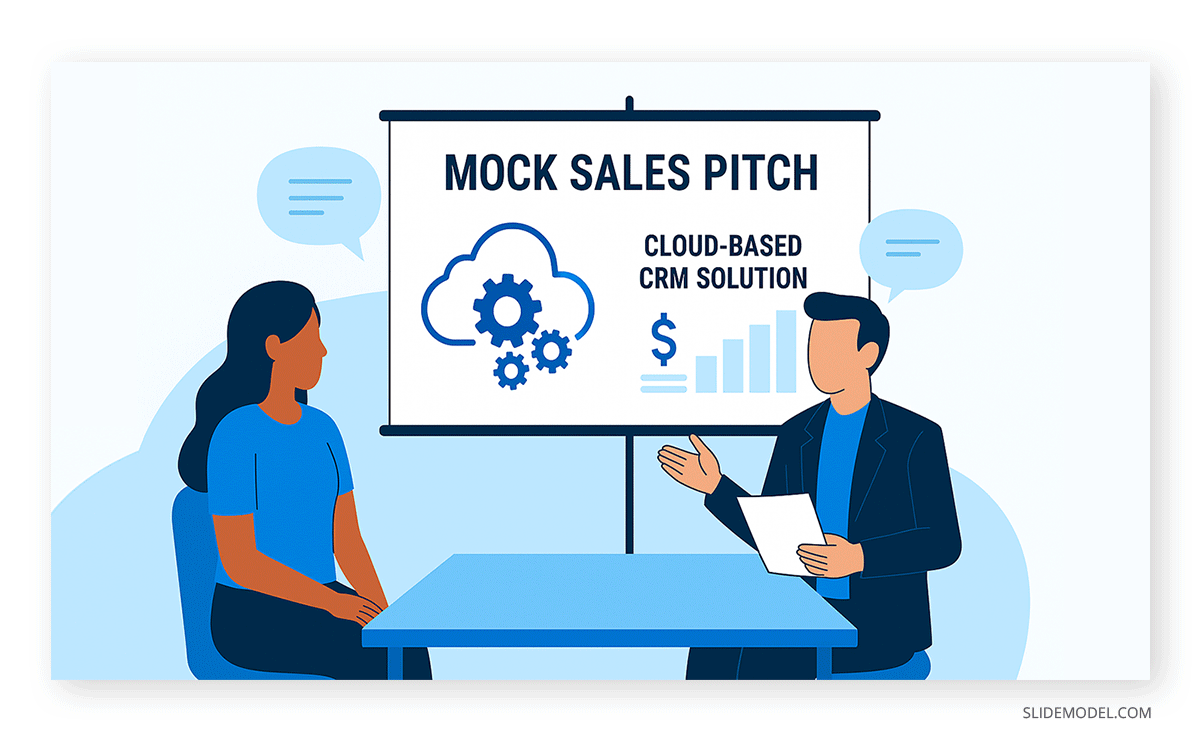
Alternatively, a mock pitching presentation intended for a start-up funding round may follow a different pattern; perhaps a 10-minute investor pitch covering market opportunity, product features, competitive landscape, team, and financials. Here, the audience would be venture capitalists, and the delivery style would likely be more assertive, data-driven, and time-conscious.
In corporate training environments, mock interview presentations may be based on role-playing exercises. You might be asked to prepare a presentation to an imaginary board of directors, a group of skeptical customers, or even internal stakeholders during a product launch. Each of these mock scenarios presents unique communication challenges; some might require persuading a hostile audience, while others test your ability to simplify technical content.

Defining a scenario also means identifying key constraints like time limits, required tools (e.g., projectors, Zoom for presentations, whiteboards), and delivery environment. You’ll want to recreate these conditions as closely as possible. This step isn’t about perfection; it’s about replicating enough variables to build comfort and expose potential flaws.
Drafting the Content and Structure
After locking down the format and scenario, your next move is to develop the content. The narrative structure of a mock presentation should follow a logical, compelling arc. Most business-related presentations, especially mock sales pitch interviews and mock pitching presentations, rely on a standard flow that starts with an introduction and ends with a strong conclusion and a call to action.
Begin with an opening that introduces the context and frames the purpose of the presentation. This should be done within the first 30 to 60 seconds to quickly orient your audience. If it’s an interview setting, mention your name and role briefly before diving into the agenda or objectives. A good opener might include a question, a relevant quote, or a problem statement that grabs attention.
Then move into the core of the content. In a sales pitch presentation, this would typically involve clearly defining the client’s pain point, followed by your solution. This is where you explain what the product or service does, how it addresses the problem, and why it’s better than competing alternatives. A mock sales pitch interview should also demonstrate knowledge of the industry, trends, and business metrics such as ROI or customer acquisition cost.

Support your claims with examples or hypothetical case studies. Even though the presentation is “mock,” the content must feel grounded and realistic. You might say, “Let’s consider a mid-size retailer with declining customer retention; using our loyalty automation tool, they saw a 15% increase in repeat purchases within three months.” These stories help contextualize abstract benefits.
Recommended lecture: Data Presentation
Before concluding, it’s valuable to briefly address potential concerns or objections. For example, if you’re simulating a mock pitching presentation and anticipate questions about scalability or pricing, introduce these points proactively. This not only shows thorough preparation but also helps control the narrative.
Finally, close with a concise presentation summary and a clear call to action slide. In an interview, this could mean inviting follow-up questions or stating how you would follow up with a real client. In other scenarios, you might propose a next meeting, a pilot project, or a deeper technical demo. Avoid ambiguous endings; make your final moments as structured as the opening.
Presentation Rehearsal
Now we jump into the presentation rehearsal mode. Start by practicing your delivery out loud. Reading in your head is not the same as verbal delivery. Speak your lines as if you were addressing a live audience. This helps you identify unnatural phrasing, excessive jargon, or weak transitions between slides. If possible, practice in the actual room where you’ll present or in a space that simulates its acoustics and lighting.
Time yourself rigorously. Employers or clients often have tight schedules, and failing to stick to time limits, even in a mock sales pitch interview, is viewed negatively. If you find you’re rushing or dragging, adjust content accordingly by condensing explanations or cutting less essential examples.
Record yourself using your phone, webcam, or a screen recording tool. Watch the playback to evaluate your tone, gestures, posture, pacing, and clarity. Many people discover unconscious habits, such as saying “um,” avoiding eye contact, or swaying side to side, only after viewing themselves. PowerPoint Rehearse with Coach tool is amazingly handy to spot unknown presentation delivery mistakes.
After solo practice, perform the full mock presentation in front of others. Ask friends, colleagues, or mentors to watch and give structured feedback. Encourage them to act as your real audience, ask tough questions, or play skeptical clients. Their interruptions will test your composure and allow you to fine-tune your responses.
Simulating Real-World Conditions
To maximize the effectiveness of your presentation rehearsal, simulate the conditions of the actual event as closely as possible. If you’re preparing for an in-person pitch, rehearse standing up with a clicker, using a laptop, and projecting onto a screen. If it’s a virtual presentation, use the same video conferencing software that will be used for the final delivery.
Dress appropriately during your rehearsal, especially for a mock sales pitch interview. This may feel excessive, but your attire influences how you perceive yourself and how others respond. Wearing professional clothing during your mock presentation shifts your mental state and helps you practice feeling confident in the environment.
Replicate other details, too. If your audience in the real event will be senior executives, include someone with senior experience in your feedback group. If you’re using animations or embedded videos in your deck, make sure they function properly on the rehearsal platform. This is your chance to identify technical issues before they happen under pressure.
Treat the Q&A session as part of the main event. Many presenters underestimate how critical this section is. For a mock interview presentation, the ability to respond on the spot while maintaining composure is often more telling than the prepared speech. Practice handling tough, unexpected questions without becoming defensive or evasive. Use the STAR method (Situation, Task, Action, Result) to respond to behavioral or scenario-based questions concisely.
How to Evaluate a Mock Presentation
After completing your mock presentation, it’s essential to perform a detailed evaluation. Don’t just ask if it “went well.” Assess each component methodically. Was the message clear? Did the structure support your narrative? Were transitions between sections smooth and logical? Did your visuals enhance or hinder the delivery?
If you recorded the session, watch it with a critical eye. Look for verbal tics, excessive gestures, pacing issues, or lack of vocal variety. Evaluate how you handled tough questions or interruptions. Did you maintain control? Were your responses data-driven and persuasive?
Recommended lecture: Presentation Skills
Ask your test audience for feedback that’s specific and actionable. Rather than general impressions, prompt them with questions like “Was the problem definition clear?” or “Did the value proposition stand out in the first five minutes?” Use this input to refine your content, slides, and delivery.
Apply revisions immediately and rehearse again. This iterative approach helps internalize changes and builds mental muscle memory. By the third or fourth run-through, you’ll start to feel more natural and in control, even when the stakes increase.
7 Best Mock Presentation Ideas
Product Launch Pitch
Simulate launching a new product to potential clients, executives, or investors. Start by identifying the market gap, then present the product’s features, value proposition, and competitive advantages. Include a brief demo or visual walkthrough and end with a clear call to action. This type of mock presentation strengthens persuasive skills, helps you practice simplifying complex features, and tests your ability to build excitement around an offering. Ideal for mock sales pitch interviews or preparing for real-world client presentations, this scenario also improves storytelling and confidence under time constraints.
Job Interview Presentation
Prepare a mock interview presentation for a role you’re targeting. Choose a topic related to the job, like a project case study, industry analysis, or strategic proposal, and present it as if you’re speaking to the hiring panel. Focus on clarity, structure, and impact. Show how your ideas align with the company’s goals. This idea is perfect for practicing the tone, pacing, and message control needed in professional interviews. It also forces you to articulate your thought process and value clearly, which is critical in roles involving communication, leadership, or strategic planning.
Investor Pitch Simulation
Create a mock pitching presentation for an imaginary start-up. Develop a full pitch deck: problem, solution, product, market size, competition, team, and revenue model. Your goal is to convince fictional investors to fund your idea. This scenario helps build fluency in business storytelling, financial reasoning, and high-level persuasion. It’s especially useful for entrepreneurs or professionals applying for business development roles. The exercise also teaches you how to explain ROI and defend your assumptions under pressure, essential for high-stakes decision-making environments.
Internal Project Proposal
Imagine you’re presenting a new initiative to senior leadership at your company. Your mock presentation should include background context, objectives, expected impact, required resources, and implementation plan. This format is ideal for improving your ability to defend a project, justify costs, and present data clearly. It helps practice aligning messaging with business priorities and stakeholder expectations. This idea is especially useful for team leads, analysts, or consultants who must regularly present findings or recommend actions internally.
Technical Product Demo
Prepare a short demo-based presentation where you explain how a tool or system works. The audience may be clients, users, or non-technical stakeholders, so clarity is key. Use simple language, visual aids, and real-world use cases to walk through features or workflows. This kind of mock presentation builds your ability to communicate complex information in an accessible way; a must-have skill in tech, SaaS, or product management roles. It also helps develop pacing and on-the-fly troubleshooting during live demos.
Recommended lecture: Saas Presentation
Sales Objection Handling Pitch
Rehearse a mock sales presentation where the audience challenges your pricing, features, or timeline. Prepare your pitch, but allow mock participants to interrupt with tough questions or concerns. This format strengthens your objection-handling skills and helps you stay composed under pressure. It also forces you to support claims with data and customize your pitch on the fly. Excellent for sales reps, account managers, or anyone preparing for a mock sales pitch interview that tests real-world selling scenarios.
Crisis Communication Response
Simulate addressing the media or internal staff after a company crisis. Prepare a mock presentation with a summary of the incident, steps taken, and future preventive measures. This idea strengthens your ability to remain calm, speak clearly, and handle emotionally charged situations. It’s ideal for PR professionals, corporate leaders, or team managers. The focus is on tone, transparency, and clarity, helping you practice how to manage difficult conversations while protecting credibility and trust.
Recommended lecture: Communication Plan Template
FAQs
Why should I do a mock presentation before a real one?
Mock presentations help you improve delivery, identify weak points, test timing, refine your visuals, and build confidence. Practicing in advance makes you less likely to freeze, ramble, or go off-topic when it matters most.
What’s the difference between a mock presentation and a real one?
A mock presentation simulates the real event but in a safe environment, usually with colleagues, mentors, or alone. The goal is rehearsal, feedback, and improvement, not persuasion or final outcomes.
How long should a mock presentation be?
Match the expected length of your actual presentation. For job interviews, most mock interview presentations last 10–15 minutes. If you’re simulating a client pitch, the range might be 15–30 minutes, including Q&A.
Can I do a mock presentation alone?
Yes, especially early in your preparation. Record yourself or practice in front of a mirror. However, you’ll get more value when you rehearse in front of someone else who can give feedback or simulate real-world pressure.
What if I feel awkward practicing in front of people?
That’s normal; most people do. Start small with a trusted friend or record yourself first. Over time, exposing yourself to mock audiences builds resilience and reduces stage fright.
How do I simulate Q&A in a mock presentation?
Have your audience ask questions at the end or interrupt you mid-presentation. If rehearsing alone, write down likely questions and answer them aloud as part of your presentation rehearsal routine.
Can a mock presentation help me get hired?
Yes. Many employers use mock sales pitch interviews to evaluate candidates’ communication skills, confidence, industry knowledge, and ability to handle objections. A well-prepared mock presentation can make a strong impression.
Final Thoughts
A mock presentation isn’t just a dry practice run; it’s your chance to get comfortable with your message, test how it flows, and figure out what works (and what doesn’t) before the real thing. Whether you’re prepping for a mock sales pitch interview, running through a presentation rehearsal, or doing a mock pitching presentation for team feedback, the process is the same: get clear on your goal, build your content, practice out loud, and refine as you go.
Every stage, planning, rehearsing, adjusting, helps you present in a way that feels natural and confident. The more you explore different mock presentation ideas, the better equipped you’ll be to adapt to new situations and audiences. Over time, you’ll build not just one solid pitch but a whole set of communication skills you can rely on.
